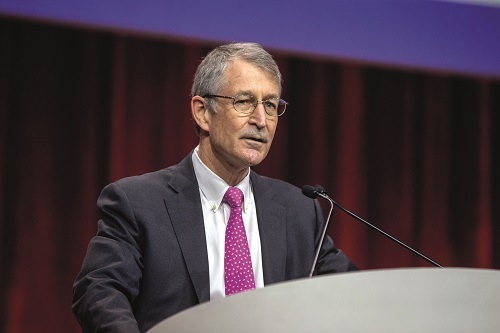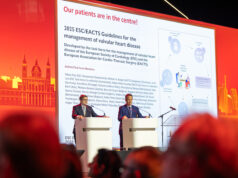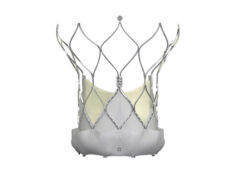
“Disappointed is an understatement,” Michael Reardon (Houston Methodist DeBakey Heart & Vascular Center, Houston, USA) said of the results of the ACURATE IDE trial comparing the Acurate neo2 (Boston Scientific) transcatheter aortic valve implantation (TAVI) device to two contemporary TAVI systems.
Results of the trial, a prospective, multicentre, randomised study, intended to support regulatory approval for the Acurate platform in the USA, were presented by Reardon at TCT 2024 (27–30 October, Washington, DC, USA). There, Reardon reported that Acurate neo2 failed to meet non-inferiority against two competitor valves—Evolut (Medtronic) or Sapien 3 (Edwards Lifesciences)—across a combined endpoint of all-cause mortality, stroke or rehospitalisation at one year.
Investigators have stated that the comparison was “complicated” by a challenging trial environment, with much of the enrolment occurring during the COVID-19 pandemic. Sites were also relatively unexperienced in using the investigational device compared to those used in the control arm, Reardon said, with only 10% of enrolling physicians at the trial’s 70 sites throughout the USA having carried out more than 10 cases with Acurate neo2.
“We started this several months before the first COVID-19 wave and it took us 47 months to complete,” said Reardon. “The average time between Acurate implants was three months, and only three sites did one a month, so there was not much experience with this valve, while we were continuing to do control valves multiple times every week.”
Despite what he described as limited operator experience with the Acurate neo2 platform, Reardon reported that early outcomes with the device were “encouraging”, with periprocedural outcomes that appeared in line with those seen in the control arm, no anomalies in echocardiography outcomes such as mean valve gradient and paravalvular regurgitation, and no acute safety signals.
However, one-year composite rates of all-cause mortality, stroke or rehospitalisation stood at 16.16% in the Acurate neo2 arm and 9.53% in the control arm, meaning that Acurate neo2 did not meet the prespecified 8% margin for non-inferiority. The disparity between 30-day and one-year outcomes prompted Reardon and the study team to probe the potential mechanisms underlying the findings. What they found was a clear signal that under-expansion of the implanted valve may have been linked to the negative outcomes.
“We went back and looked at these and saw some of the valves did not look fully expanded, by looking at the posts not being parallel. We had engineers blinded out and go back and look at every case, and they found about 20% of these were under-expanded,” Reardon explained.
Understanding of the factors that contributed to the negative outcome of the trial could, the investigators say, provide important knowledge to the field.
“Under-expanded valves had higher flows, turbulent flow and reduced washout. That is a very plausible reason for platelet activation and clumping possible micro-emboli which could affect later strokes and later myocardial ischaemia. When we look at time to event, what we saw with under-expanded valves was that you had double the risk of all-cause mortality and triple the risk of stroke.”
Speaking to Cardiovascular News, Reardon said that despite operator inexperience with the Acurate neo2, it proved to be an easy and reliable valve to implant with early results in line with the commercially tested valves.
“Operator inexperience was manifest as lack of recognition of under expansion. Under expanded valves had twice the risk of mortality and three times the risk of stroke compared to expanded valves,” he said. Reardon hopes that the ability to recognise and treat under expansion will lead to better outcomes going forward.
The significance of valve under-expansion was picked up by Ole De Backer (Rigshospitalet, Copenhagen, Denmark) at PCR London Valves (24–27 November, London, UK) where he discussed analysis of outcomes amongst patients receiving Acurate neo2 in Europe.

“We identified, not in 20% as in the US trial, but in 9% of our patients who had an Acurate neo2 implanted, valve under-expansion. And, indeed, we confirmed that in this 9% of patients with an under-expanded Acurate neo2 valve, there were higher events of mortality and stroke,” De Backer revealed. “We could repeat this ACURATE IDE trial, which makes it clear that valve under-expansion is the root-cause of the clinical issues seen between 30 days and one year.”
De Backer echoed the comment that TAVI operators should be aware of the potential impact of transcatheter aortic valve under-expansion on outcomes regardless of the platform that they are using, and advised that performing post-dilatation can eliminate this valve under-expansion and clinical complications.
“For me as a TAVI implanter using a lot of different platforms, this is not only important for this particular platform. What we see in ACURATE IDE and in our European cohort is the understanding that we should not only consider valve post-dilatation in case of PVL or residual high trans-prosthetic gradients, but also in case of important valve under-expansion, whether it is a balloon-expandable valve, or any self-expanding platform,” he said. “I think we have to become better at detecting this during our case, and if we see valve under-expansion, to address it.”










